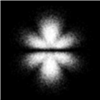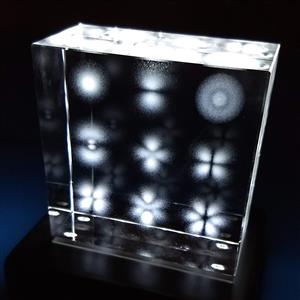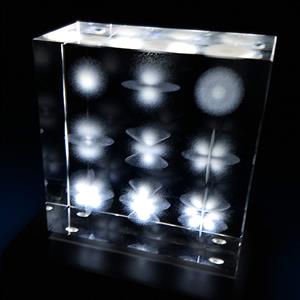Standing Waves in Atoms
Concluding Activity
Summary: Students simply look at some pictures (or models) of atomic orbitals and see that they look somewhat like Chladni patterns. Atoms are made of standing waves!
This is a short concluding activity, intended to immediately follow the Chladni plates activity, if there is time.
Time: 5 minutes. Ages: 8 to 16. Number of students: any number.
Materials and Preparation
Atomic Orbitals Chart
Prepare to show a chart with pictures of several atomic orbitals (also called electron orbitals). The chart may be printed on paper or displayed on a screen.
For this activity, choose pictures of atomic orbitals that look somewhat like Chladni patterns. Specifically:
- Use pictures that show the orbitals as clouds of dots. These look
somewhat like Chladni patterns. Do NOT use pictures that show the orbitals
as balloons with smooth surfaces. These do NOT look like Chladni patterns.

clouds - yes 
surfaces - no - Use a chart showing many orbital shapes, especially some of the d and/or f orbitals that have many lobes. The flower-shaped orbitals look somewhat like the star-shaped Chladni patterns.
- You may want to use pictures with white or light-colored dots on a dark background. They look like white salt/sand on a dark Chladni plate.
For example, here's my atomic orbitals chart. You can print it, display it on a screen, or buy the poster.
It is not difficult to find other atomic orbitals charts that meet the above criteria. Try these search keywords: atomic orbital electron probability density.
Note: You may find some pictures of electron orbitals that also show the nodal surfaces (planes, cones, and spheres) of zero electron probability. These nodal surfaces are somewhat analogous to the nodal lines in a Chladni plate.
3D Models of Atomic Orbitals (optional)
A wonderful visual prop for this activity is one or more 3D models showing different atomic orbitals. 3D models are cool, but not necessary for this short activity. However, if you teach science, especially high school chemistry or physics, you may find other uses for 3D models of orbitals.
For this activity, choose 3D models showing orbitals that look somewhat like Chladni patterns. Specifically:
- Use 3D models that show the orbitals as clouds of dots. These are typically laser-etched glass crystal.
- Use 3D models with several orbital shapes, especially some of the d and/or f orbitals that have many lobes.
For example, here are photos of my laser crystals.


It may be difficult to find 3D models of orbitals that meet the above criteria. You can buy one from Bathsheba Sculpture.
Activity
Presentation
Show the students the pictures (and/or 3D models) of atomic orbitals that look like clouds of dots, somewhat like Chladni patterns. The pictures may be printed on paper, small or large, or displayed on a screen. For lower grade levels, tell the students that these are pictures of atoms. For higher grade levels, say each picture is an atomic orbital (also called an electron orbital), which is an electron cloud surrounding the nucleus of an atom. Do not try to explain more! You can't explain quantum mechanics in five minutes!
Observation
Ask the students to point to atomic orbitals that look somewhat like their Chladni patterns. Ask them how they are similar. We merely expect the students to recognize that the atomic orbitals do indeed look somewhat like Chladni patterns. Students may recognize that both patterns are made of fuzzy patches that are symmetrical around the center. They may say the star-shaped Chladni patterns are sort of like the flower-shaped atomic orbitals.
Conclusion
After the students have had a moment to observe, tell the students that atoms are actually made of standing waves, like the Chladni patterns. If necessary, you can explain a little more: atoms are made of particles (electrons, protons, neutrons, quarks) and each particle is a kind of standing wave. Finally, you can wow them with this mind-blowing thought: Everything (every object on Earth) is made of atoms, and atoms are made of standing waves, so everything is made of standing waves!
Remember, this is not a lesson about atomic orbitals. This is just a final kicker following the Chladni plate activity. The only goal of this brief concluding activity is for the students to learn that atoms are made of some kind of standing waves. There is no need to explain more! You can tell younger students that they will learn more about this when they are older. You can tell older students that they can learn more by looking up "atomic orbitals" or "electron orbitals".
Extra
For higher grade levels, if you have extra time, you may want to talk about the dimensionality of standing waves (and nodes) in strings, plates, and atoms:
- Standing waves in strings: A string is basically a one-dimensional line. The stationary nodes are points (zero dimensions).
- Standing waves in Chladni plates: A plate is basically a two-dimensional surface. The stationary nodes are one-dimensional lines, straight or curved.
- Standing waves in atoms: An electron orbital is three-dimensional. The nodes of zero electron probability are two-dimensional surfaces: planes, cones, and spheres.


